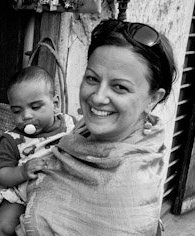Noreen Mucha has over 14 years of experience working in international development, primarily focusing in the public health sector but also within the agriculture and education sectors. Experience includes working with host country governments, United Nations, international nongovernmental organizations, non profits and universities. 
Question: Please give a brief description of your current work with the Global Alliance for Improved Nutrition (GAIN)?
Currently, I am conducting a 14 country nutrition and nutrition-sensitive landscape analysis for the DFID-global project m-nutrition in which Global Alliance for Improved Nutrition (GAIN) is a consortia member along with CAB Institute, the International Livestock Research Institute (ILRI), OXFAM, and the British Medical Journal (BMJ). The ultimate goal of the mNutrition Initiative is to contribute to improving nutrition and food security of the poor, especially women, by harnessing the power of mobile technologies to improve access to information on nutrition-specific behaviors as well as nutrition-sensitive health and agricultural practices especially for farmers and the rural population particularly women and adolescent girls.
Question: What is your latest publication and what were 1 or 2 of the main findings?
My latest publication was with the CMAM (Community Management for Acute Malnutrition) Forum entitled “Preventing Moderate Acute Malnutrition (MAM) Through Nutrition-Sensitive Interventions.” Some key findings included:
- A combination of short-and long-term interventions to prevent MAM can help build longer-term resilience whilst also responding to needs arising due to the local seasonal context. Seasonal food insecurity and other changes associated with seasonality, such as an increase in infections or inadequate caring practices, need to be taken into consideration in order to reduce seasonal peaks in wasting.
- Studies demonstrate significant results in reduction of wasting when addressing underlying conditions such as poor WASH conditions, inadequate food security, and poor caring practices. In terms of WASH, most evidence demonstrates that the promotion of a clean and sanitary environment for infants and young children and addressing faecal-oral transmission pathways, especially exploratory ingestion of soil and chicken faeces in infants and young children (birth–18 months old), due to the very high bacterial load of these substances is the most effective intervention to help prevent MAM.
Question: What do you think are some of the main issues regarding the integration of WASH and Nutrition?
One of the greatest challenges is the vertical sectors and the fact that most health programs do not integrate WASH adequately. WASH experts are not familiar with the underlying causes of malnutrition and nutrition experts are not familiar with improved sanitation and water. Furthermore, there is more need for high-level advocacy to integrate them at the Ministry level within countries, backed by resources. Some donors are taking this step to release new bids with integrated nutrition and WASH.
Question: What are some of the greatest challenges of scaling up nutrition including the integration of WASH?
The greatest challenge is lack of coordination. Most donors and implementing partners fail to coordinate resulting in significant duplication of resources and lowered impact. The SUN Movement is a successful start to coordination at the country level, however it is generally unfunded. More resources need to be allocated for coordination and strengthening the capacity to support integrated programs at both the HQ levels as well as country level.





Comments on this entry are closed.